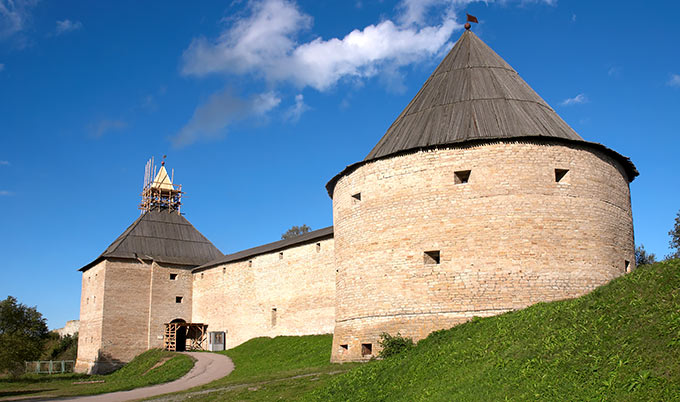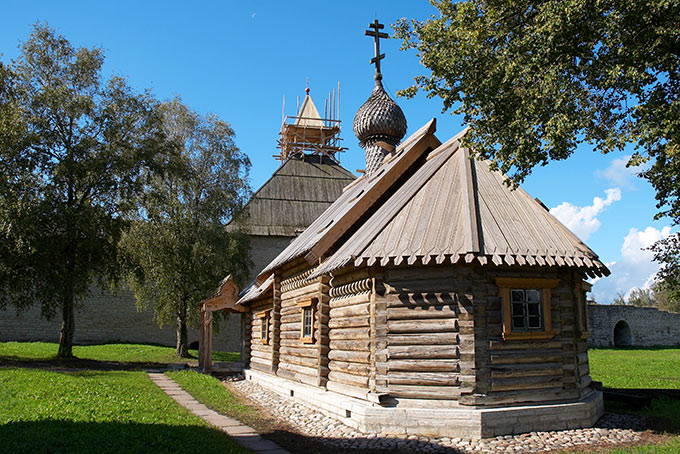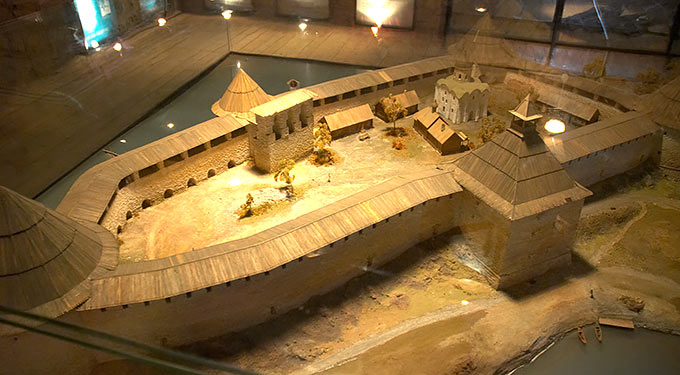History of Staraya Ladoga fortress
This is an oldest city in Russia. It was referred in 862 for the first time in ancient annals concerning calling of three Varangian Rurick brothers as crisis managers for the Russia Land, in connection with extensiveness of its territory and absence of any order. Those annals informed that elder brother, who has wooden settlement here and became the ruler of Russian Lands.
The site for the building the fortress is very convenient indeed. There was the main trade waterway from "Varangians to Greeks" by the river of Volkhov and so there were great possibilities to make big profit of that. The sea of Ladoga is only 15 km away. This place was the capital of Russia for a short time, but soon Rurick moved the capital to Novgorod by politic reasons.
In 1114 the first stone fortress in Russia was erected by the novgorod posadnik Pavel. Ladoga became a large trading city from now on, with numerous fairs, crafts, trades, et cetera..
In 1164 a Swedish army with 55 vessels appeared under the walls of the fortress. They undertook fierce storm but were defeated and forced to escape. In Ladoga Lake they were intercepted by the Novgorod militia and were beaten hard in addition.
In 1313 Swedes seized and burned the Ladoga fortress at last, but could not stay here for very long and were forced to escape again. In 1338 the fortress was stormed unsuccessfully by Swedes again.
In the 15th century the fortress was totally reconstructed in connection with quick fire-arms developments.
In Time of Troubles (1610) Swedes again grasped the fortress for 6 years. In 1701 there was the last unsuccessful storm of Ladoga by the Swedish army.
In 1704 the whole local administration and trading were moved to the small town Novaya Ladoga near the Ladoga Lake under Peter's I order. This was the beginning of fading the ancient city. With the construction of railway in 1860th the trading transportations over the river of Volkhov were in practice stopped.
Nowadays Staraya Ladoga is the little and fading village on the banks of the river of Volkhov.
Impressions
Very positive impressions as a whole. It is a pity that the fortress is too small and distant. The weather was very hot. But it was possibility to jump into the Volkhov river. There was the ice-cream seller in the stall near the bus stop. The saleswoman was so kind, she showed the visitors the time-table of buses to Volhovstroj (incorrect ones, I should say).
Repair works are carried on in the fortress (repairs instead of restoration). The restored buildings of fortress seems too much new.
There are two museums in the fortress with a small entrance fee - 30 roubles (1 euro in 2005) in the fortress museum and both churches.
Land forts and fortress:
Bip Castle Gatchina Ivangorod Izborsk Kexholm Kirillov Monastery Koporye Novgorod Pechorskiy Monastery Peter&Paul Fortress Porkhov Pskov Schlisselburg Staraya Ladoga Tikhvin Vyborg Hameenlinna Hamina Kastelholm Kymenlinna Lappaenranta Raseborg Castle Savonlinna Tavetti Turku Visby Fredrikstadt Fredriksten Hegra Fort Hoytorp Fort Arensburg Narva Tallinn Antipatris Caesarea Jerusalem Latrun Fort Masada
Sea forts and fortresses:
Alexander Fort Ino Fort Krasnaya Gorka Fort Kronstadt: Kotlin isl. Kronstadt: North Forts Kronstadt: South Forts Trongsund Hanko Svartholm Sveaborg Marstrand Siaro Fort Vaxholm Oscarsborg
Artillery batteries and individual guns:
Coastal Artillery Hemso Fort
Fortified areas and defensive lines:
Karelian Fortified Area (KaUR) KrUR Leningrad Mannerheim Line Nevsky Bridgehead VT Line Harparskog Line Salpa Line Gothland
Russian
S e a r c h All news





 The Vorotnaja (Gate) Tower
The Vorotnaja (Gate) Tower